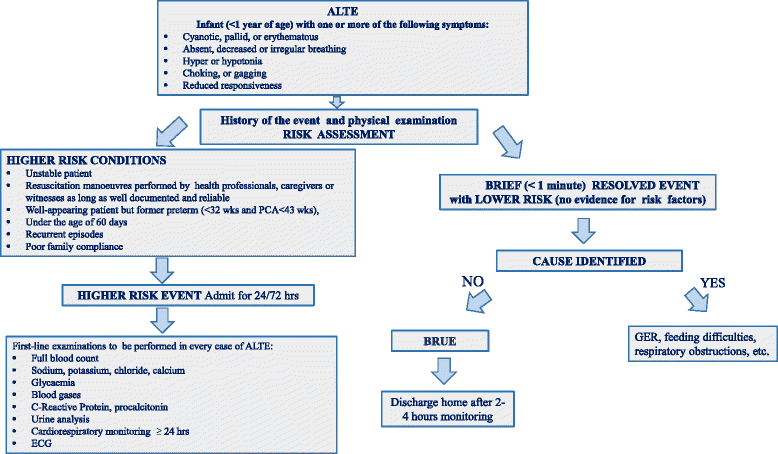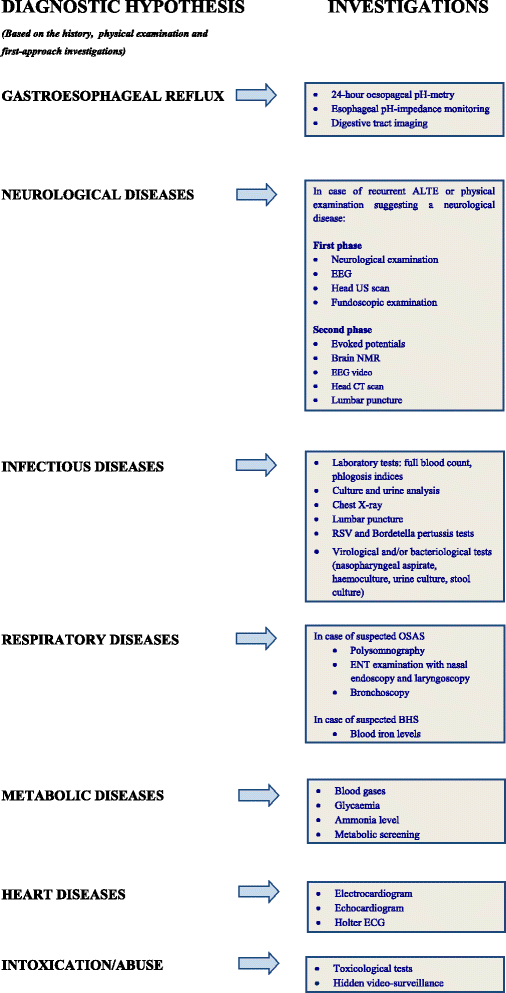Apparent Life-Threatening Events (ALTE): Italian guidelines
- PMID: 29233182
- PMCID: PMC5728046
- DOI: 10.1186/s13052-017-0429-x
Apparent Life-Threatening Events (ALTE): Italian guidelines
Abstract
Five years after the first edition, we have revised and updated the guidelines, re-examining the queries and relative recommendations, expanding the issues addressed with the introduction of a new entity, recently proposed by the American Academy of Pediatrics: BRUE, an acronym for Brief Resolved Unexplained Events. In this manuscript we will use the term BRUE only to refer to mild, idiopathic cases rather than simply replace the acronym ALTE per se.In our guidelines the acronym ALTE is used for severe cases that are unexplainable after the first and second level examinations.Although the term ALTE can be used to describe the common symptoms at the onset, whenever the aetiology is ascertained, the final diagnosis may be better specified as seizures, gastroesophageal reflux, infection, arrhythmia, etc. Lastly, we have addressed the emerging problem of the so-called Sudden Unexpected Postnatal Collapse (SUPC), that might be considered as a severe ALTE occurring in the first week of life.
Keywords: Apparent life-threatening events; Brief resolved unexplained events; Sudden unexpected early neonatal death; Sudden unexpected postnatal collapse.
Conflict of interest statement
Ethics approval and consent to participate
Not applicable.
Consent for publication
Not applicable.
Competing interests
The authors declare that no conditions exist in which the professional judgements regarding the validity of the studies examined or the formulating of the recommendations could in any way be influenced by secondary interests such as economic benefits or personal interest. The authors declare that they have no competing interests.
Publisher’s Note
Springer Nature remains neutral with regard to jurisdictional claims in published maps and institutional affiliations.
Figures
References
-
- ISS Istituto Superiore di Sanità: SNLG-Sistema Nazionale per le Linee Guida. 2004. http://www.snlg-iss.it. Accessed 24 Apr 2017.
-
- Network Pediatrico. Società Italiana di Pediatria GSA (Gruppo di Studio per l’Accreditamento e il Miglioramento Continuo della Qualità), Italia. 2009. http://www.networkpediatrico.sip.it. Accessed 24 April 2017.
-
- American Academy of Pediatrics National Institutes of Health consensus development conference on infantile apnea and home monitoring, Sept 29 to Oct 1, 1986. Pediatrics. 1987;79:292–299. - PubMed
-
- Angle B, Burton BK. Risk of sudden death and acute life-threatening events in patients with glutaric acidemia type II. Mol Genet Metab. 2008;93:36–9. - PubMed
Publication types
MeSH terms
LinkOut - more resources
Full Text Sources
Other Literature Sources
Medical



